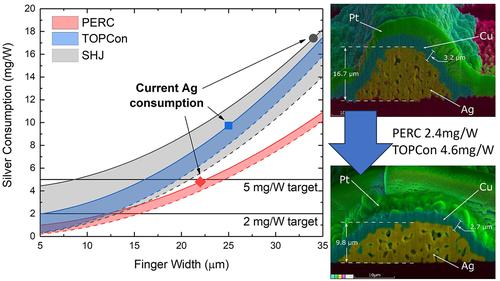当前位置:
X-MOL 学术
›
Prog. Photovoltaics
›
论文详情
Our official English website, www.x-mol.net, welcomes your feedback! (Note: you will need to create a separate account there.)
Silver‐lean metallization and hybrid contacts via plating on screen‐printed metal for silicon solar cells manufacturing
Progress in Photovoltaics ( IF 6.7 ) Pub Date : 2024-03-23 , DOI: 10.1002/pip.3799 Yuan‐Chih Chang 1 , Yuchao Zhang 1 , Li Wang 1 , Sisi Wang 1 , Haoran Wang 1 , Chien‐Yu Huang 1 , Ran Chen 1 , Catherine Chan 1 , Brett Hallam 1
Progress in Photovoltaics ( IF 6.7 ) Pub Date : 2024-03-23 , DOI: 10.1002/pip.3799 Yuan‐Chih Chang 1 , Yuchao Zhang 1 , Li Wang 1 , Sisi Wang 1 , Haoran Wang 1 , Chien‐Yu Huang 1 , Ran Chen 1 , Catherine Chan 1 , Brett Hallam 1
Affiliation

|
As PV manufacturing heads towards the multi‐TW scale, it is required to carefully evaluate a wide range of concepts including not only efficiency and cost but also material consumption to ensure sustainable manufacturing of PV technologies. The rapid growth of PV could significantly increase the demand for several materials required in solar cells such as silver, aluminium, copper and even silicon, thereby causing dramatic price fluctuations. Furthermore, the PV manufacturing capacity would be at risk of being limited by the supply of some scarce metals, e.g. with current industrial implementations – screen printing (SP) metallization, the capacities of PERC and TOPCon could be capped at 377 GW and 227 GW with 20% of global silver supply available to the PV industry. In addition, PV systems have ~25–30 years lifespan to ensure low LCOE and emissions. Recycling alone will not provide an immediate solution to overcome the limitation of material consumption in the exponentially growing PV market. It is expected that the Ag usage needs to be reduced to no more than 5 mg/W or even 2 mg/W for all solar cell technologies to allow a multi‐TW manufacturing scale without depleting the global silver supply. Therefore, further advancements in metallization technologies are critically and urgently required to significantly reduce the silver consumption of current screen‐printed contacts in industrial silicon solar cells. This paper firstly presents a roadmap towards the 5 mg/W and 2 mg/W silver consumption targets with various metallization technologies and screen‐printing designs. Subsequently, a hybrid plating on screen‐printed metallization design was proposed to improve the performance and reduce the silver consumption of screen‐printed contacts. The experimental results have demonstrated up to 1.08%abs improvements in fill factor and 0.3%abs gains in cell efficiency. In addition, up to 40%rel reductions in finger silver consumption have been achieved without any sacrifices in the electrical conductivity of such hybrid screen‐printed and plated fingers. This work proposes not only a roadmap but also a promising approach to significantly reduce the Ag demand and benefit sustainable production of industrial screen‐printed silicon solar cells in the TW era.
中文翻译:

用于硅太阳能电池制造的贫银金属化和通过在丝网印刷金属上电镀的混合接触
随着光伏制造走向多TW规模,需要仔细评估各种概念,不仅包括效率和成本,还包括材料消耗,以确保光伏技术的可持续制造。光伏发电的快速增长可能会显着增加对太阳能电池所需多种材料的需求,例如银、铝、铜甚至硅,从而导致价格剧烈波动。此外,光伏制造能力将面临受到某些稀有金属供应限制的风险,例如,根据当前的工业实施——丝网印刷(SP)金属化,PERC和TOPCon的产能可能被限制在377吉瓦和227吉瓦,全球白银供应量的 20% 可供光伏行业使用。此外,光伏系统的使用寿命约为 25-30 年,以确保较低的 LCOE 和排放。在指数级增长的光伏市场中,仅回收并不能提供立即解决材料消耗限制的解决方案。预计所有太阳能电池技术的银用量都需要减少至不超过 5 mg/W 甚至 2 mg/W,以便在不耗尽全球白银供应的情况下实现多TW 制造规模。因此,迫切需要进一步进步金属化技术,以显着降低工业硅太阳能电池中当前丝网印刷触点的银消耗。本文首先提出了通过各种金属化技术和丝网印刷设计实现 5 mg/W 和 2 mg/W 银消耗目标的路线图。随后,提出了丝网印刷金属化设计上的混合电镀,以提高丝网印刷触点的性能并减少银的消耗。实验结果表明高达1.08%腹肌 填充因子提高 0.3%腹肌 电池效率的提高。此外,高达40%相对 在不牺牲这种混合丝网印刷和电镀手指的导电性的情况下,减少了手指银的消耗。这项工作不仅提出了一个路线图,而且提出了一种有前景的方法,可以显着减少银需求,并有利于 TW 时代工业丝网印刷硅太阳能电池的可持续生产。
更新日期:2024-03-23
中文翻译:

用于硅太阳能电池制造的贫银金属化和通过在丝网印刷金属上电镀的混合接触
随着光伏制造走向多TW规模,需要仔细评估各种概念,不仅包括效率和成本,还包括材料消耗,以确保光伏技术的可持续制造。光伏发电的快速增长可能会显着增加对太阳能电池所需多种材料的需求,例如银、铝、铜甚至硅,从而导致价格剧烈波动。此外,光伏制造能力将面临受到某些稀有金属供应限制的风险,例如,根据当前的工业实施——丝网印刷(SP)金属化,PERC和TOPCon的产能可能被限制在377吉瓦和227吉瓦,全球白银供应量的 20% 可供光伏行业使用。此外,光伏系统的使用寿命约为 25-30 年,以确保较低的 LCOE 和排放。在指数级增长的光伏市场中,仅回收并不能提供立即解决材料消耗限制的解决方案。预计所有太阳能电池技术的银用量都需要减少至不超过 5 mg/W 甚至 2 mg/W,以便在不耗尽全球白银供应的情况下实现多TW 制造规模。因此,迫切需要进一步进步金属化技术,以显着降低工业硅太阳能电池中当前丝网印刷触点的银消耗。本文首先提出了通过各种金属化技术和丝网印刷设计实现 5 mg/W 和 2 mg/W 银消耗目标的路线图。随后,提出了丝网印刷金属化设计上的混合电镀,以提高丝网印刷触点的性能并减少银的消耗。实验结果表明高达1.08%



























 京公网安备 11010802027423号
京公网安备 11010802027423号